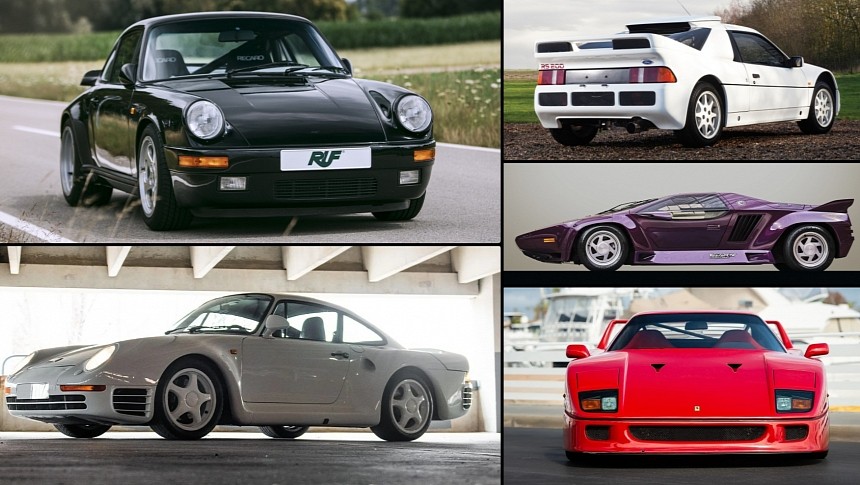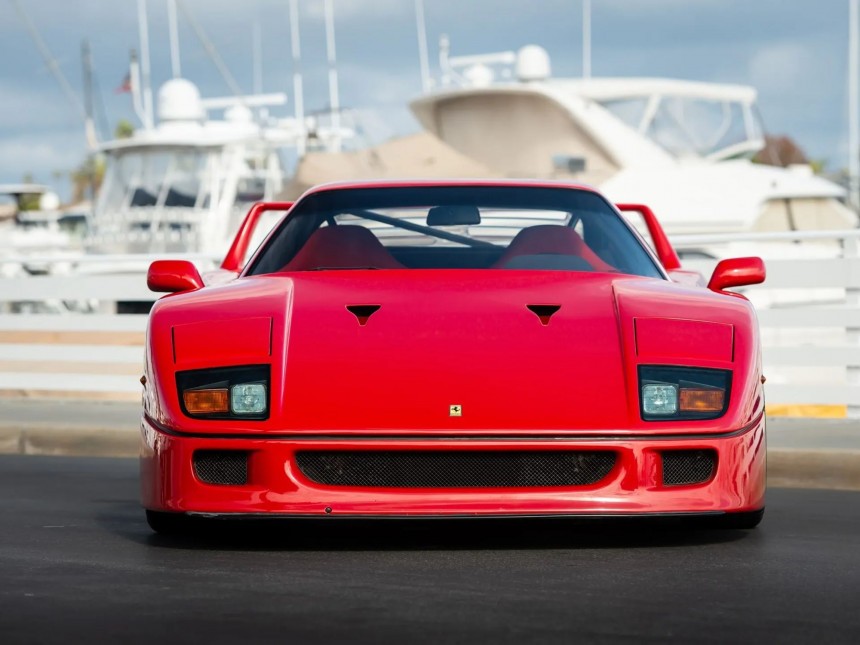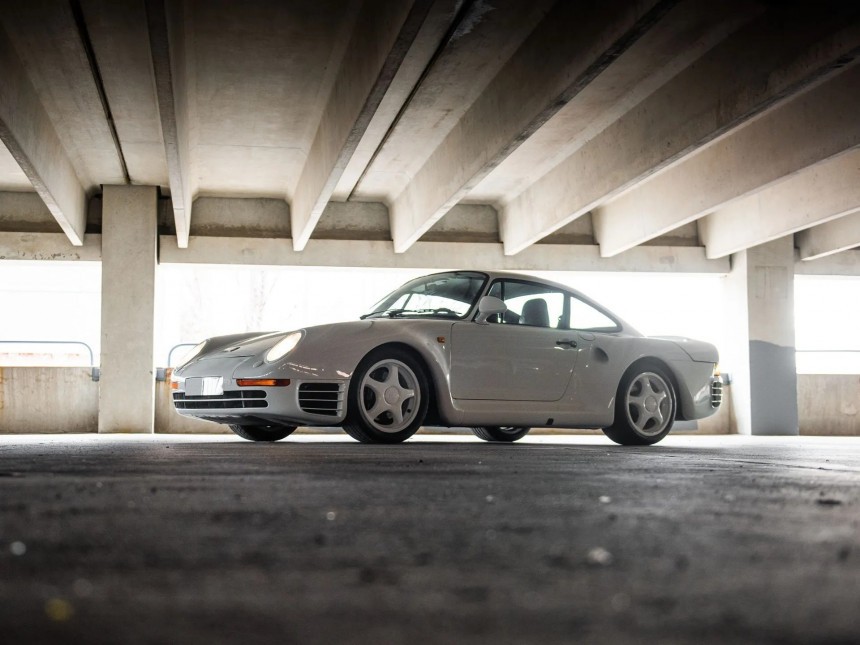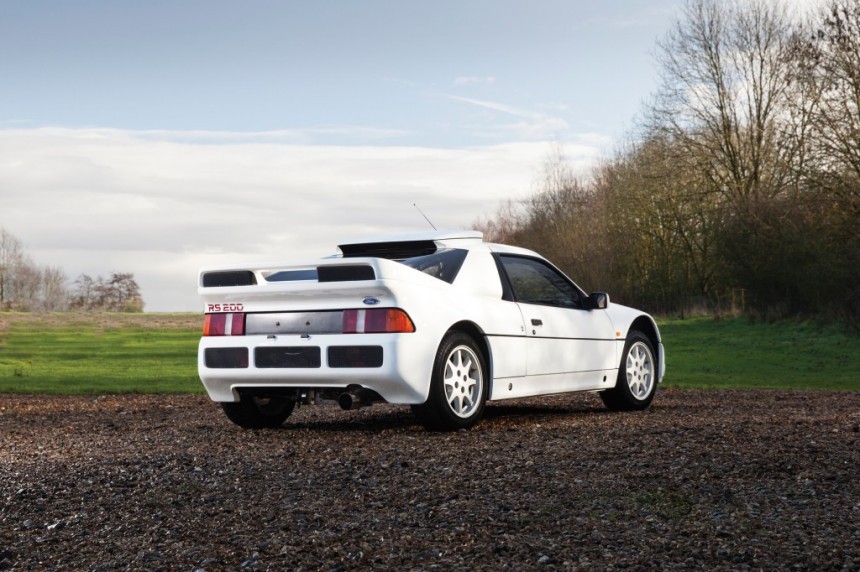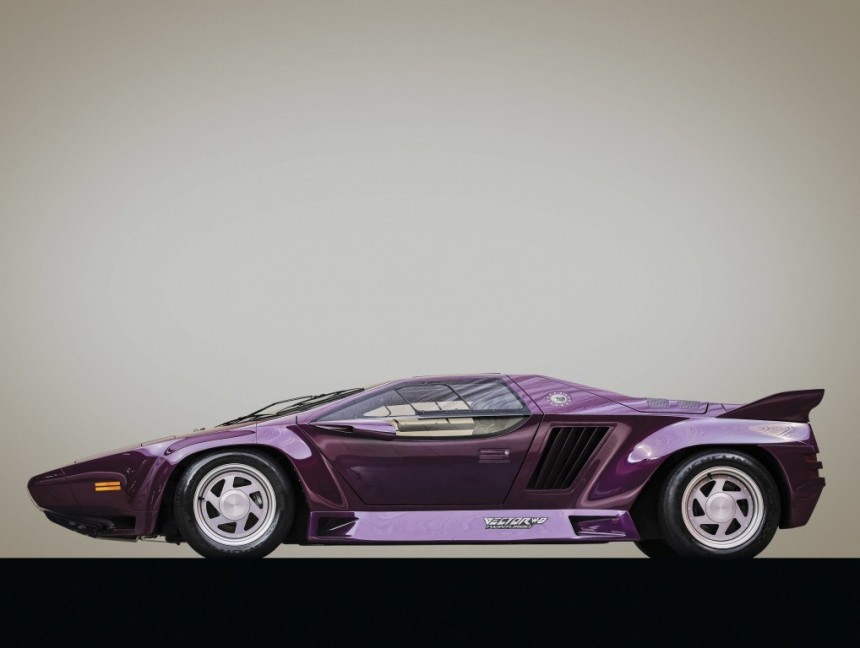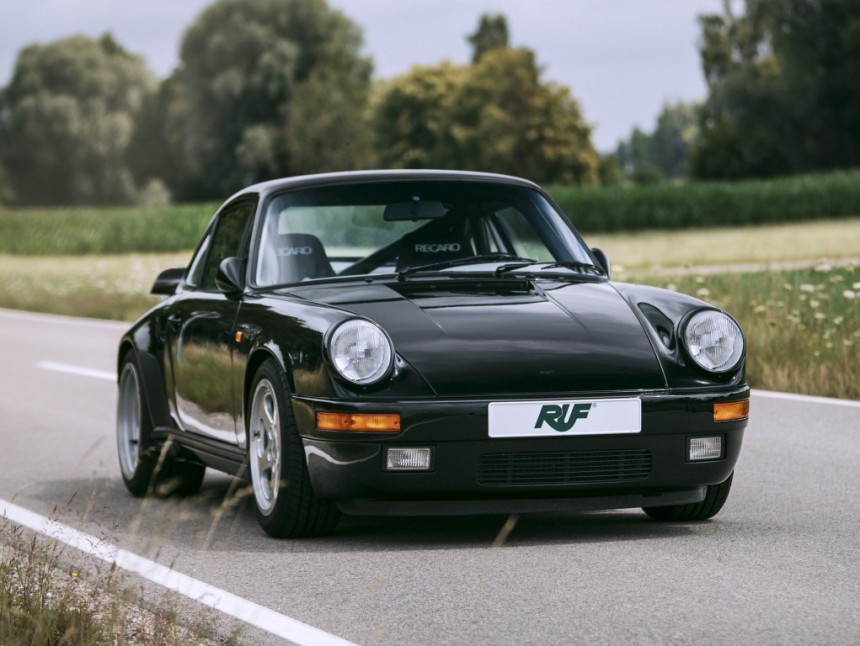The 1980s are described as the decade of excess, and that's fully correct from a capitalist's point of view. Behind the Iron Curtain, on the other hand, life was pretty rough in Warsaw Pact signatory countries due to economic decline. It's also worth remembering that Regular Joes and Janes living under the communist yoke didn't have too many new car makes and models to choose from, whereas people in the West could splash out on everything from superminis like the Ford Fiesta to exotic supercars like the Lamborghini Countach.
One of the most enduring supercars ever, Marcello Gandini's wedge-shaped masterpiece ran between 1974 to 1990 in just under 2,000 units. The V12-powered icon didn't make our list of the best supercars from the '80s because it's too old of a design by 1980s standards.
Many others did not make our list either, including the love-it-or-hate-it Aston Martin V8 Zagato and the Ferrari 288 GTO homologation special. Not even the DeLorean DMC-12 is featured, partly because its Peugeot-Renault-Volvo V6 doesn't live up to the car's looks and the customer's performance expectations.
The British, Italian, and American legends in the aforementioned paragraph shouldn't be dismissed either because all three are special in their own way. But alas, we only had room for 5 supercars. On that note, let's kick off with the usual suspects from Italy and Germany, as in those specific bedroom-poster-material supercars that are always featured in best-1980s-supercars stories.
We all know Enzo Ferrari wanted to deliver something that would eviscerate the Porsche 959, fair and square. We also know that Il Commendatore ordered his team of crack engineers to make the best car in the world. The F40 is Enzo's final masterpiece, and so much more.
Only 400 examples of the breed were originally planned for production, although the Prancing Horse of Maranello would eventually finish a little over 1,300 units due to clamoring demand. Only 213 were delivered stateside, and pre-1990 models are especially desirable because said cars don't feature catalytic converters.
Early F40s are even more desirable because Ferrari originally used less than two liters of paint for the sake of lightness. A purely mechanical beast with no driver aids whatsoever, the F40 isn't much to the liking of McLaren F1 mastermind Gordon Murray. Considering how much one costs in this day and age (over $2 million), Murray's criticism over chassis flex and wobbling will not put off any prospective collector.
Referred to as Gruppe B early during development, the 959 wouldn't have been possible without the 961 racing car. To understand how special the 959 is, remember that Bill Gates bought one in 1988. Said vehicle was stored for 13 years by the Customs Service. Coincidentally, the Show or Display law wouldn't have been passed without immense pressure from Bill and his buddies, including Microsoft co-founder and fellow 959 owner Paul Allen.
Porsche did not design its most technologically advanced car – at the time – in accordance with NHTSA and DOT standards for the US market. Zuffenhausen instead preferred the European motor vehicle standards due to the unfavorable exchange rate between the Deutsche Mark and USD, and the automaker was fully aware that it wasn't going to build too many 959s.
Just over 300 were produced between 1986 and 1993. The rear-engined thriller could achieve 211 miles per hour (339 kilometers per hour), and the only transmission available came in the guise of a six-speed manual of the dogleg variety, consisting of reverse, a gelände (terrain) forward gear, and five normal forward ratios. The weirdly named gelände isn't an off-road gear as one may assume, but a clever way to pass noise regulations. G is actually first gear, whereas 1 is second, and so forth. The tests were performed in 3, which is actually fourth in the 959, and that's how Porsche cleverly managed to keep the noise below 80 dB.
Hideously underrated for all the wrong reasons, the RS200 is a classic that should be remembered in the same breath as the GT40 and GT. Not the recently discontinued second-generation GT with the boring twin-turbo V6 lump from a half-ton pickup truck, but the original with the Shelby GT500's blown V8 mill.
Unfortunately for the Dearborn-based manufacturer, the RS200 had barely seen racing action before Group B's demise after the death of Henri Toivonen and Sergio Cresto in 1986. Developed from the ground up specifically for the World Rally Champion's most extreme formula ever, the Rally Sport 200 was meant to number at least 200 units. FoMoCo pulled the plug after 148 vehicles were completed, including development prototypes that were – rather tragically – destroyed.
In addition to its rarity, diminutive footprint, and Cosworth-designed turbocharged four-pot engine, the RS200 also stands out because of its originality. All the other Group B rally cars – including the Audi Quattro and Lancia Delta - had series-production cousins. By comparison, the RS200 was a clean-sheet design. A good one will set you back in excess of $300,000 at auction nowadays, or more for an Evolution spec.
The rarest car in this ranking is overlooked as well, even more so than the RS200. The man behind Vector Motors, automotive engineer and businessman Gerald Wiegert, knew that he couldn't build heritage overnight. Even today, newcomers in the supercar biz simply cannot challenge the likes of Ferrari or Lamborghini. But Wiegert knew that he could build reputation fast by developing the W8 to shock and awe with its outlandish design and race-proven Rodeck twin-turbo V8.
Fewer than 20 cars were produced from 1989 through 1993. Back then, four-speed automatics were the norm in the American automotive industry. Vector modified the General Motors Turbo-Hydramatic 425 for this application, an old-fashioned transmission with three forward gears that had been used nearly two decades earlier in the front-driven Oldsmobile Toronado.
The de Dion-style rear suspension is archaic in its own right. Be that as it may, the W8 can hit a manufacturer-claimed 242 miles per hour (389 kilometers per hour). No motoring publication was allowed or could verify said claim, but Road & Track did estimate the W8's top speed as being 218 mph (351 kph). In other words, even this conservative estimate would've bested the likes of the 959 and F40, plus the 1990 to 2001 Diablo.
Ruf Automobile GmbH is a bonafide automaker, not a tuner of all things Porsche. The German outfit came to prominence in the latter part of the 1980s with the CTR, which is best described as a 911 Carrera 3.2 on steroids. The heavily modified Neunelfer was named CTR after Group C racing, its twin-turbo boxer, and the gentleman who founded the Auto Ruf service garage in 1939.
There are plenty of myths surrounding the CTR, and most of them are true. Nicknamed Yellowbird by Road & Track's photographers during testing, the rear-engined monster cranks out 463 horsepower from 3.4 liters and six cylinders. But similar to how BMW likes to roll with its inline-six engines, the horizontally-opposed sixer modified by Ruf actually produced more ponies.
Thanks to all-wheel drive, the 959 was quicker to 60 miles per hour (97 kilometers per hour) than the CTR. But on a long-enough straightaway, the Yellowbird made easy work of the Neun Fünf Neun. High speed means little without handling, and boy, does the Yellowbird handle! Unofficially faster at the Nurburgring than other series-production exotica of that era, the CTR can hold its own against much newer metal, including the E92 BMW M3 (also 8:05) and C209 Mercedes-Benz CLK 63 AMG Black Series (8:05).
Many others did not make our list either, including the love-it-or-hate-it Aston Martin V8 Zagato and the Ferrari 288 GTO homologation special. Not even the DeLorean DMC-12 is featured, partly because its Peugeot-Renault-Volvo V6 doesn't live up to the car's looks and the customer's performance expectations.
The British, Italian, and American legends in the aforementioned paragraph shouldn't be dismissed either because all three are special in their own way. But alas, we only had room for 5 supercars. On that note, let's kick off with the usual suspects from Italy and Germany, as in those specific bedroom-poster-material supercars that are always featured in best-1980s-supercars stories.
Ferrari F40
Only 400 examples of the breed were originally planned for production, although the Prancing Horse of Maranello would eventually finish a little over 1,300 units due to clamoring demand. Only 213 were delivered stateside, and pre-1990 models are especially desirable because said cars don't feature catalytic converters.
Early F40s are even more desirable because Ferrari originally used less than two liters of paint for the sake of lightness. A purely mechanical beast with no driver aids whatsoever, the F40 isn't much to the liking of McLaren F1 mastermind Gordon Murray. Considering how much one costs in this day and age (over $2 million), Murray's criticism over chassis flex and wobbling will not put off any prospective collector.
Porsche 959
Porsche did not design its most technologically advanced car – at the time – in accordance with NHTSA and DOT standards for the US market. Zuffenhausen instead preferred the European motor vehicle standards due to the unfavorable exchange rate between the Deutsche Mark and USD, and the automaker was fully aware that it wasn't going to build too many 959s.
Just over 300 were produced between 1986 and 1993. The rear-engined thriller could achieve 211 miles per hour (339 kilometers per hour), and the only transmission available came in the guise of a six-speed manual of the dogleg variety, consisting of reverse, a gelände (terrain) forward gear, and five normal forward ratios. The weirdly named gelände isn't an off-road gear as one may assume, but a clever way to pass noise regulations. G is actually first gear, whereas 1 is second, and so forth. The tests were performed in 3, which is actually fourth in the 959, and that's how Porsche cleverly managed to keep the noise below 80 dB.
Ford RS200
Unfortunately for the Dearborn-based manufacturer, the RS200 had barely seen racing action before Group B's demise after the death of Henri Toivonen and Sergio Cresto in 1986. Developed from the ground up specifically for the World Rally Champion's most extreme formula ever, the Rally Sport 200 was meant to number at least 200 units. FoMoCo pulled the plug after 148 vehicles were completed, including development prototypes that were – rather tragically – destroyed.
In addition to its rarity, diminutive footprint, and Cosworth-designed turbocharged four-pot engine, the RS200 also stands out because of its originality. All the other Group B rally cars – including the Audi Quattro and Lancia Delta - had series-production cousins. By comparison, the RS200 was a clean-sheet design. A good one will set you back in excess of $300,000 at auction nowadays, or more for an Evolution spec.
Vector W8
Fewer than 20 cars were produced from 1989 through 1993. Back then, four-speed automatics were the norm in the American automotive industry. Vector modified the General Motors Turbo-Hydramatic 425 for this application, an old-fashioned transmission with three forward gears that had been used nearly two decades earlier in the front-driven Oldsmobile Toronado.
The de Dion-style rear suspension is archaic in its own right. Be that as it may, the W8 can hit a manufacturer-claimed 242 miles per hour (389 kilometers per hour). No motoring publication was allowed or could verify said claim, but Road & Track did estimate the W8's top speed as being 218 mph (351 kph). In other words, even this conservative estimate would've bested the likes of the 959 and F40, plus the 1990 to 2001 Diablo.
RUF CTR Yellowbird
There are plenty of myths surrounding the CTR, and most of them are true. Nicknamed Yellowbird by Road & Track's photographers during testing, the rear-engined monster cranks out 463 horsepower from 3.4 liters and six cylinders. But similar to how BMW likes to roll with its inline-six engines, the horizontally-opposed sixer modified by Ruf actually produced more ponies.
Thanks to all-wheel drive, the 959 was quicker to 60 miles per hour (97 kilometers per hour) than the CTR. But on a long-enough straightaway, the Yellowbird made easy work of the Neun Fünf Neun. High speed means little without handling, and boy, does the Yellowbird handle! Unofficially faster at the Nurburgring than other series-production exotica of that era, the CTR can hold its own against much newer metal, including the E92 BMW M3 (also 8:05) and C209 Mercedes-Benz CLK 63 AMG Black Series (8:05).
